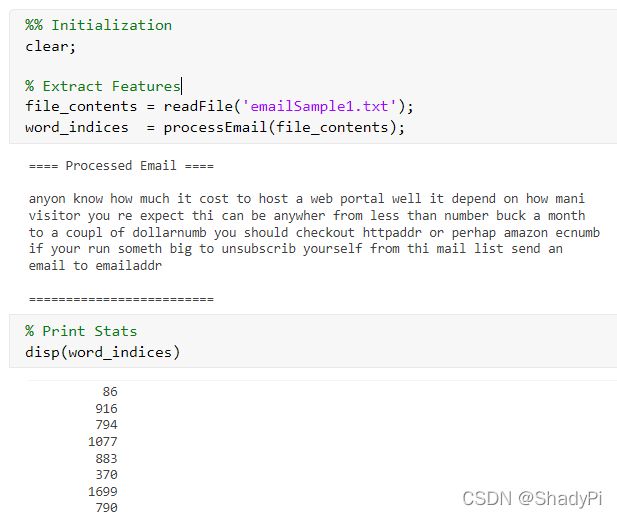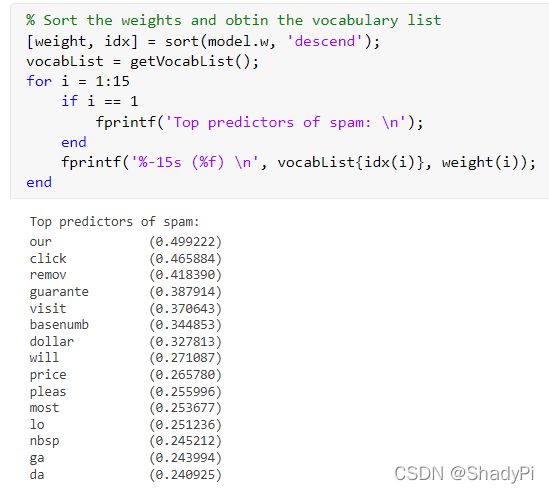机器学习:使用matlab实现SVM完成垃圾邮件识别
文章目录
- 预处理
- 词库映射
- 构造特征向量
- 训练
预处理
在开始机器学习之前,多观察数据集中的数据通常很有帮助。比如在下面这封邮件里

我们可以看到一个 URL、一个电子邮件地址(在末尾)、数字和美元金额。
虽然许多电子邮件会包含类似类型的文本(例如,数字、其他 URL 或其他电子邮件地址),但几乎每封电子邮件中的这些文本都会有所不同。
因此,处理电子邮件时常用的一种方法是将这些值“标准化”,以便所有 URL 都被视为相同,所有数字都被视为相同等。例如,我们可以将电子邮件中的每个 URL 替换为唯一的字符串“httpaddr”表示存在 URL。这具有让垃圾邮件分类器根据是否存在任何 URL 而不是特定 URL 是否存在来做出分类决定的效果。这通常会提高垃圾邮件分类器的性能,因为垃圾邮件发送者通常会随机化 URL,因此在新的垃圾邮件中再次看到任何特定 URL 的几率非常小。
在 processEmail.m 中,我们实现了以下电子邮件预处理和规范化步骤:
- 小写:将整个电子邮件转换为小写,因此忽略大写(例如,将 IndIcaTE 视为与指示相同)。
- 剥离 HTML:从电子邮件中删除所有 HTML 标记。许多电子邮件通常带有 HTML 格式。我们删除了所有的 HTML 标记,因此只保留了内容。
- 规范化 URL:所有 URL 都替换为文本“httpaddr”。
- 标准化电子邮件地址:所有电子邮件地址都替换为文本“emailaddr”。
- 规范化数字:所有数字都替换为文本“数字”。
- 标准化美元:所有美元符号 ($) 都替换为文本“美元”。
- 词干:词被简化为词干形式。例如,‘discount’、‘discounts’、‘discounted’和’discounting’都替换为’discount’。有时,Stemmer 实际上会从末尾剥离额外的字符,因此“包含”、“包含”、“包含”和“包含”都被替换为“包含”。
- 去除非单词:去除非单词和标点符号。所有空格(制表符、换行符、空格)都已被修剪为单个空格字符。
词库映射
另外,我们还需要将数据中的单词替换为数字,即用单词在我们词库里的索引来替代字符串。字典库包含所有信件中出现次数超过100的单词(如果囊括太多词汇,包括那些仅出现过几次的,很可能会出现过拟合),共1899个。
在 MATLAB 中,可以使用 strcmp 函数比较两个字符串。例如,strcmp(str1, str2)仅当两个字符串相等时才会返回 1。在提供的起始代码中,vocabList 是一个包含词汇表中单词的cell-array。在 MATLAB 中,除了它的元素也可以是字符串(它们不能在普通的 MATLAB 矩阵/向量中),cell-array就像一个普通数组(即向量),可以大括号对它们进行索引。
前两个部分的函数如下:
function word_indices = processEmail(email_contents)
%PROCESSEMAIL preprocesses a the body of an email and
%returns a list of word_indices
% word_indices = PROCESSEMAIL(email_contents) preprocesses
% the body of an email and returns a list of indices of the
% words contained in the email.
%
% Load Vocabulary
vocabList = getVocabList();
% Init return value
word_indices = [];
% ========================== Preprocess Email ===========================
% Find the Headers ( \n\n and remove )
% Uncomment the following lines if you are working with raw emails with the
% full headers
% hdrstart = strfind(email_contents, ([char(10) char(10)]));
% email_contents = email_contents(hdrstart(1):end);
% Lower case
email_contents = lower(email_contents);
% Strip all HTML
% Looks for any expression that starts with < and ends with > and replace
% and does not have any < or > in the tag it with a space
email_contents = regexprep(email_contents, '<[^<>]+>', ' ');
% Handle Numbers
% Look for one or more characters between 0-9
email_contents = regexprep(email_contents, '[0-9]+', 'number');
% Handle URLS
% Look for strings starting with http:// or https://
email_contents = regexprep(email_contents, ...
'(http|https)://[^\s]*', 'httpaddr');
% Handle Email Addresses
% Look for strings with @ in the middle
email_contents = regexprep(email_contents, '[^\s]+@[^\s]+', 'emailaddr');
% Handle $ sign
email_contents = regexprep(email_contents, '[$]+', 'dollar');
% ========================== Tokenize Email ===========================
% Output the email to screen as well
fprintf('\n==== Processed Email ====\n\n');
% Process file
l = 0;
while ~isempty(email_contents)
% Tokenize and also get rid of any punctuation
[str, email_contents] = ...
strtok(email_contents, ...
[' @$/#.-:&*+=[]?!(){},''">_<;%' char(10) char(13)]);
% Remove any non alphanumeric characters
str = regexprep(str, '[^a-zA-Z0-9]', '');
% Stem the word
% (the porterStemmer sometimes has issues, so we use a try catch block)
try str = porterStemmer(strtrim(str));
catch str = ''; continue;
end;
% Skip the word if it is too short
if length(str) < 1
continue;
end
% Look up the word in the dictionary and add to word_indices if
% found
% ====================== YOUR CODE HERE ======================
% Instructions: Fill in this function to add the index of str to
% word_indices if it is in the vocabulary. At this point
% of the code, you have a stemmed word from the email in
% the variable str. You should look up str in the
% vocabulary list (vocabList). If a match exists, you
% should add the index of the word to the word_indices
% vector. Concretely, if str = 'action', then you should
% look up the vocabulary list to find where in vocabList
% 'action' appears. For example, if vocabList{18} =
% 'action', then, you should add 18 to the word_indices
% vector (e.g., word_indices = [word_indices ; 18]; ).
%
% Note: vocabList{idx} returns a the word with index idx in the
% vocabulary list.
%
% Note: You can use strcmp(str1, str2) to compare two strings (str1 and
% str2). It will return 1 only if the two strings are equivalent.
%
idx=find(strcmp(str,vocabList));
word_indices=[word_indices;idx];
% =============================================================
% Print to screen, ensuring that the output lines are not too long
if (l + length(str) + 1) > 78
fprintf('\n');
l = 0;
end
fprintf('%s ', str);
l = l + length(str) + 1;
end
% Print footer
fprintf('\n\n=========================\n');
end
做完前两步处理,我们的信件就从一封信变成一个数字向量了。
%% Initialization
clear;
% Extract Features
file_contents = readFile('emailSample1.txt');
word_indices = processEmail(file_contents);
% Print Stats
disp(word_indices)
构造特征向量
对于一封信,它的特征向量就是词库里的某个词有没有在这封信里出现过,有则该项为1,没有则是0,很简单:
function x = emailFeatures(word_indices)
%EMAILFEATURES takes in a word_indices vector and produces a feature vector
%from the word indices
% x = EMAILFEATURES(word_indices) takes in a word_indices vector and
% produces a feature vector from the word indices.
% Total number of words in the dictionary
n = 1899;
% You need to return the following variables correctly.
x = zeros(n, 1);
% ====================== YOUR CODE HERE ======================
% Instructions: Fill in this function to return a feature vector for the
% given email (word_indices). To help make it easier to
% process the emails, we have have already pre-processed each
% email and converted each word in the email into an index in
% a fixed dictionary (of 1899 words). The variable
% word_indices contains the list of indices of the words
% which occur in one email.
%
% Concretely, if an email has the text:
%
% The quick brown fox jumped over the lazy dog.
%
% Then, the word_indices vector for this text might look
% like:
%
% 60 100 33 44 10 53 60 58 5
%
% where, we have mapped each word onto a number, for example:
%
% the -- 60
% quick -- 100
% ...
%
% (note: the above numbers are just an example and are not the
% actual mappings).
%
% Your task is take one such word_indices vector and construct
% a binary feature vector that indicates whether a particular
% word occurs in the email. That is, x(i) = 1 when word i
% is present in the email. Concretely, if the word 'the' (say,
% index 60) appears in the email, then x(60) = 1. The feature
% vector should look like:
%
% x = [ 0 0 0 0 1 0 0 0 ... 0 0 0 0 1 ... 0 0 0 1 0 ..];
%
%
for i=1:length(word_indices)
x(word_indices(i))=1;
end
% =========================================================================
end
训练
让数据中的每封信都经过上面的处理之后,我们就可以进行常规的SVM训练了:
% Load the Spam Email dataset
% You will have X, y in your environment
load('spamTrain.mat');%这里加载的是已经处理好的数据
C = 0.1;
model = svmTrain(X, y, C, @linearKernel);
p = svmPredict(model, X);
fprintf('Training Accuracy: %f\n', mean(double(p == y)) * 100);
% Load the test dataset
% You will have Xtest, ytest in your environment
load('spamTest.mat');
p = svmPredict(model, Xtest);
fprintf('Test Accuracy: %f\n', mean(double(p == ytest)) * 100);
最后得到的训练集准确率 99.85 % 99.85\% 99.85%,测试集准确度 98.9 % 98.9\% 98.9%
通过观察模型的参数,我们可以看看包含什么词的更容易被我们的分类器当作垃圾邮件:
% Sort the weights and obtin the vocabulary list
[weight, idx] = sort(model.w, 'descend');
vocabList = getVocabList();
for i = 1:15
if i == 1
fprintf('Top predictors of spam: \n');
end
fprintf('%-15s (%f) \n', vocabList{idx(i)}, weight(i));
end

